Abstract
Thurstonian scaling, i.e., Thurstonian discriminal distance or , can be used as a sensory measurement index to measure and monitor food sensory difference/similarity between test and control samples due to potential food contamination. It can be obtained from any one of the sensory discrimination methods. Thurstonian scaling is theoretically independent of the methods or scales used for its estimation. This paper discusses statistical inference including estimations and tests of hypothesis for . Ten basic sensory discrimination methods including six forced-choice methods and four methods with response bias are used in this paper to estimate values and their variances. Statistical tests are conducted based on the estimated values and their variances. The statistical tests include difference testing and equivalence/similarity testing for individual values for test and control samples and for two or multiple values for test samples. The application and significance of Thurstonian scaling for sensory discrimination methods are discussed generally. R codes for estimations and tests for values are provided in the paper.
1. Introduction
Contamination may lead to changes of food sensory properties and consumers’ sensory perceptions. Sensory discrimination methods can be used to detect the sensory difference/similarity of samples.
Sensory discrimination methods are an important methodology of Sensory and Consumer Science. For more about sensory discrimination methods, see, e.g., Meilgaard et al. [1], Lawless and Heymann [2], Stone et al. [3], Rogers [4], Rogers et al. [5], and various ASTM and ISO Standards about sensory discrimination methods (see ASTM [6,7,8,9,10,11,12] and ISO [13,14,15,16,17]).
Thurstonian scaling, i.e., Thurstonian discriminal distance δ or , which can be regarded as an estimator of δ, provides a unified framework for the sensory discrimination methods. Thurstonian discriminal distance can be estimated from a Thurstonian model, i.e., a psychometric function for any one of the sensory discrimination methods, and can be used as a unique sensory measurement index. An advantage of is that it is theoretically independent of the methods or scales used for its estimation. “As such, δ provides a common scale of measure for comparing samples measured under a variety of test conditions.” (ASTM-E2262-03 [7]).
For more details about Thurstonian models of sensory discrimination methods, see, e.g., Thurstone [18], Ura [19], David and Trivedi [20], Bradley [21], Frijters [22,23], Ennis et al. [24], Ennis [25,26], Ennis and Rousseau [27], Bi et al. [28], Bi [29,30,31], Bi and O’Mahony [32], Bi and Kuesten [33,34], Bi et al. [35,36,37], Brockhoff and Christensen [38], Ennis [39], Ennis and Christensen [40], Ennis et al. [41], Rousseau and O’Mahony [42], and Rousseau and Ennis [43]. Signal Detection Theory (SDT) is also an important theoretical source of Thurstonian models of sensory discrimination methods. For SDT, see, e.g., Green and Swets [44], Macmillan and Creelman [45], and Hautus et al. [46]. The R package ‘sensR’ (Christensen et al. [47]) provides R programs for calculations of values from some basic sensory discrimination methods. Additionally, novel uses of Thurstonian modeling may be found, including applicability scoring by Ennis and Ennis [48] and scaling of ratings data by Warnock et al. [49].
The main objectives of this paper include the following: (1). to estimate and its variance from some basic sensory discrimination methods; (2). to conduct statistical testing including difference testing and equivalence/similarity testing for individual for a test sample and a control sample in a sensory discrimination method; (3). to conduct statistical testing including difference testing, equivalence/similarity testing, and multiple comparisons for multiple values for multiple test samples; (4). to discuss generally the application and significance of Thurstonian scaling for sensory discrimination methods; (5). to develop and provide corresponding R codes using R programs (R Core Team [50]) in the Supplementary Materials in the online version of this paper.
2. Materials and Methods
2.1. Estimating Values and Their Variances from Psychometric Functions of Some Basic Sensory Discrimination Methods
Thurstonian scaling, i.e., Thurstonian discriminal distance or can be derived from the Thurstonian models, i.e., psychometric functions of sensory discrimination methods. Any sensory discrimination method should have its unique psychometric function. The psychometric functions for the forced-choice methods describe the relationship between δ and the probability of correct response, Pc. The psychometric functions for the methods with response bias describe the relationship between δ and probabilities of hits and false alarms. The probability of hits is the probability of response “A” for sample A in the A–Not A method or the probability of response “same” for the matched sample pair in the Same–Different method. The probability of false alarms is the probability of response “A” for sample Not A in the A–Not A method or the probability of response “same” for the unmatched sample pair in the Same–Different method.
Thurstonian models, i.e., psychometric functions, can be derived theoretically based on different decision rules and/or be produced by simulations. Ennis [39] developed a simulation-derived psychometric function for the “Two-out-of-Five” method. Bi et al. [36] developed the simulation-derived psychometric functions for various forced-choice sensory discrimination methods, i.e., “M+N” methods.
Estimation of variances of estimators is another important topic for Thurstonian modeling. With the estimated and its variance, statistical testing for or is possible. Bi et al. [28] was probably the first in the sensory literature to discuss the topic. The B-values in ASTM-E2262-03 [7] for the forced-choice methods are adapted from Bi et al. [28]. Bi [30] originally derived the variance of for the Same–Different method. Bi and O’Mahony [32] also originally derived the variances of for the specified and unspecified tetrads. Bi [29] (Section 3.4) describes three general approaches for estimation of variance of . They are as follows: (1). the bootstrap method; (2). the delta method; and (3). using some S-Plus (Insightful 2001 [51]) and R programs [50] and R packages, e.g., the R package “numDeriv” (Gilbert and Varadhan [52]), based on the Hessian of the log-likelihood function evaluated at the maximum-likelihood estimation.
Table 1 lists ten (10) basic sensory discrimination methods, their psychometric functions, and corresponding R codes. The methods include three (3) specified forced-choice methods, i.e., the 2-AFC, the 3-AFC, and the specified tetrad; three (3) unspecified forced-choice methods, i.e., the triangle, the duo-trio, and the unspecified tetrad; four (4) methods with response bias, i.e., the A–Not A, the Same–Different, the ratings of A–Not A, and the ratings of Same–Different. The last two methods can be regarded as two versions of the degree of difference (DOD) method.

Table 1.
Estimations of and its variance for some basic sensory discrimination methods.
ASTM-E2262-03 [7] provides the values and corresponding B-values (note: variance = B/n, where n is the sample size) for four forced-choice methods (i.e., the triangle, the duo-trio, the 3-AFC, and the 2-AFC) and two methods with response bias (i.e., the A–Not A and the Same–Different methods). Ennis et al. [53] provide the values for the specified and unspecified tetrads. Bi and O’Mahony [32] provide variances of for the specified and unspecified tetrads. Bi et al. [35] provide the values and their variances for the ratings of the A–Not A, the ratings of A–Not AR, and the ratings of the Same–Different methods and regard them as three versions of the degree of difference (DOD) method. Ennis and Rousseau [27] and Ennis and Christensen [40] provide a version of the DOD based on the ratings of the Same–Different method.
The input of the R codes for all six forced-choice methods are x and n, i.e., the number of correct responses (x) and sample size (n).
The input of the R code for A–Not A are a, an, n, and nn, i.e., the number of response “A” for sample A (a), the sample size of sample A (an), the number of response “A” for sample Not A (n), and the sample size of sample Not A (nn).
The input of the R code for Same–Different are sn, n1, dn, and n2, i.e., the number of response “Same” for matched sample pairs (AA or BB) (sn), the sample size of matched sample pairs (n1), the number of response “Same” for the unmatched sample pairs (AB or BA) (dn), and the sample size of the unmatched sample pairs (n2).
The input of the code for the ratings A–Not A are rfal and rhit, i.e., a vector of the frequencies of the ratings of sample Not A (rfal) and a vector of the frequencies of the ratings of sample A (rhit).
The input of the R code for the ratings Same–Different are rsam and rdif, i.e., a vector of the frequencies of the ratings of matched sample pairs (AA or BB) and a vector of the frequencies of the rating of unmatched sample pairs (AB or BA).
The output of the R codes for any one of all 10 methods are the estimated and its variance.
2.2. Statistical Testing for Test Sample vs. Control Sample Based on the Individual Estimator and Its Variance
2.2.1. Difference Test for Test Sample vs. Control Sample Based on Individual and Their Variance
The difference test based on the individual value and its variance is used to determine if there is a difference between one test sample and a control. The null hypothesis is . The alternative hypothesis is . The difference test statistic based on individual value and its variance is Equation (1).
where is the 1-α-th percentile of the standard normal distribution.
2.2.2. Equivalence/Similarity Test for Test Sample vs. Control Sample Based on Individual and Its Variance
The equivalence/similarity test based on individual value and its variance is used to determine if one test sample and a control sample are equivalent/similar in terms of a given equivalence/similarity limit . This is a one-sided equivalence/similarity test with the null hypothesis: , and the alternative hypothesis: . The equivalence/similarity test statistic based on the individual value and its variance is Equation (2).
where is the α-th percentile of the standard normal distribution.
2.3. Statistical Testing for Multiple Test Samples Based on Multiple Values and Their Variances
2.3.1. Difference Test for Multiple Test Samples Based on Multiple Values and Their Variances
According to Marascuilo [54,55], the test statistic in Equation (3) can be used for a difference test for multiple based on , where j = 1, 2, …, k, and their variances.
where , which denotes a weighted mean of . The statistic in Equation (3) asymptotically follows a chi-square distribution with k − 1 degrees of freedom.
2.3.2. Multiple Comparisons for Multiple Test Samples Based on the Vector and Co-Variance Matrix
If a difference test for multiple test samples in terms of shows a significant difference among test samples, multiple comparisons can be conducted based on the vector and co-variance matrix for the estimators using S-Plus program ‘multicomp’ (Insightful [51]) or R package ‘multcomp’ (Hothorn et al. [56]).
2.3.3. TOST Equivalence/Similarity Test for Two Test Samples Based on Two Values and Their Variances
TOST, i.e., Two One-Sided Test, is a widely-used method for an equivalence/similarity test proposed by Westlake [57] and Schuirmann [58,59]. See, e.g., Bi [29] (Chapter 5) for more interpretation about the method. This test is a two-sided equivalence/similarity test which involves two sets of one-sided hypotheses: versus and versus . We can declare that and are equivalent/similar in terms of , where is a selected equivalence/similarity limit, if and only if both and are rejected at a significance level α. The test statistics for the TOST are Equations (4a) and (4b). The TOST can be used for equivalence/similarity testing for any two test samples.
where is the α-th percentile of the standard normal distribution, while is the 1-α-th percentile of the standard normal distribution.
The TOST is based on the intersection-union test (IUT) principle. A remarkable feature of the IUT is that unlike difference testing, the TOST based on the IUT principle does not need to make multiplicity adjustment to control the overall probability of Type I error for multiple comparisons using TOST equivalence/similarity tests. For the IUT theory, see, e.g., Berger [60], Casella and Berger [61], Berger and Hsu [62], and Silvapulle and Sen [63] (Chapter 5.3).
3. Results
3.1. Estimated Values and Their Variances from Psychometric Functions of 10 Basic Sensory Discrimination Methods
Examples using the R codes in Table 1 to get values and their variances are as below.
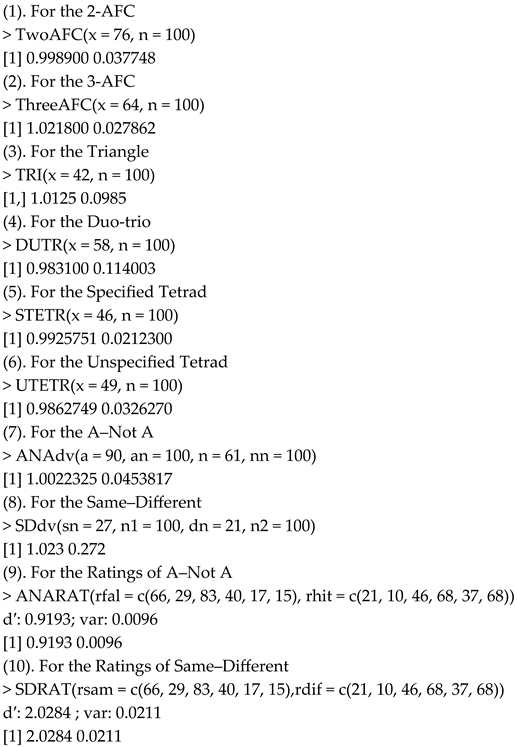
The results in the examples for the 10 sensory discrimination methods are consistent with the results in ASTM- E2262-03 [7], Ennis et al. [53], Bi and O’Mahony [32], Bi et al. [33], Bi [29] (Chapters 2–3), and the R package ‘sensR’ (Christensen et al. [47]).
For example, for the ratings of Same–Different method, i.e., a version of the DOD method, using the R code ‘SDRAT(rsam = c(66, 29, 83, 40, 17, 15), rdif = c(21, 10, 46, 68, 37, 68))’, the output is = 2.0284 and var() = 0.0211.

Using the R program ‘dod’ in ‘sensR’, which is based on Ennis and Christensen [40] and Ennis and Rousseau [27], for the ratings of the Same–Different method, a version of the DOD method, the output is as below. The results are = 2.0257 and var() = 0.1382 = 0.019044. The results are consistent with those above.
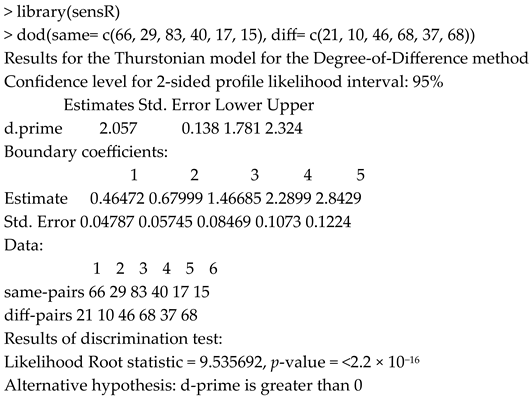
3.2. Statistical Testing for Test Sample vs. Control Sample Based on the Individual Estimator and Its Variance
3.2.1. Difference Test Based on the Individual and Their Variance
The R code ‘dpdtest(d,v)’ based on Equation (1) can be used for the difference test based on the individual value and its variance. For example, the result of the difference test is as below for the data in the first row in the data file ‘dpdat’ and in Table 2. Because the p-value is <0.01, a significant difference between test sample and control sample was found at a significance level α = 0.01.

Table 2.
Data of estimated and its variance.
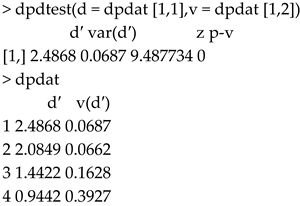
3.2.2. Equivalence/Similarity Test Based on the Individual and Its Variance
The R code ‘dpstest(d,v,slim)’ based on Equation (2) can be used for the equivalence/similarity tests based on the individual value and its variance. For example, for the similarity limits , the equivalence/similarity test results are as below for the data in the first row in Table 2 and data file ‘dpdat’. Because the p-value is 0.0251, significant equivalence/similarity between the test sample and control sample can be claimed in terms of the equivalence/similarity limit at a significance level α = 0.05.

3.3. Statistical Testing for Multiple Test Samples Based on Multiple Values and Their Variances
3.3.1. Difference Test for Multiple Test Samples Based on Multiple Values and Their Variances
The R code ‘dstest(d,v)’, based on Equation (3), can be used to conduct a difference test for multiple δ based on multiple and their variances.
For example, for a difference test for four test samples based on the four values and their variances in Table 2 (‘dpdat’), the test results are as below, using the R code ‘dstest(d,v)’. A significant difference among the four test samples was found at an alpha level of 0.05 (p-value = 0.0425).
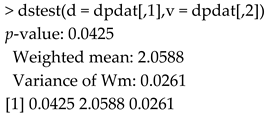
3.3.2. Multiple Comparisons for Multiple Test Samples Based on the Vector and Co-Variance Matrix
The vector ‘dp’ and co-variance matrix ‘dv’ can be produced using the data ‘dpdat’ in Table 2 as below.
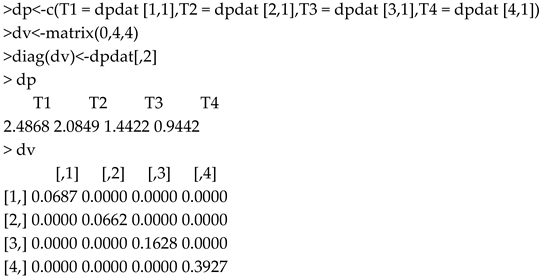
The S-Plus program ‘multicomp’ in S-Plus 6 software can be used for the multiple comparisons based on ‘dp’ and ‘dv’ with a selected alpha level, e.g., alpha = 0.2 as below. There are significant differences between T1 and T3 and between T1 and T4, based on δ.
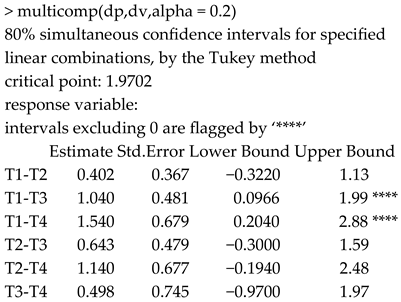
The R programs ‘confint’, glht’, and ‘parm’ in R package ‘multcomp’ can also be used for the multiple comparisons based on ‘dp’ and ‘dv’ with a selected confidence level (1-alpha), e.g., 0.8 (alpha = 0.2) as below.
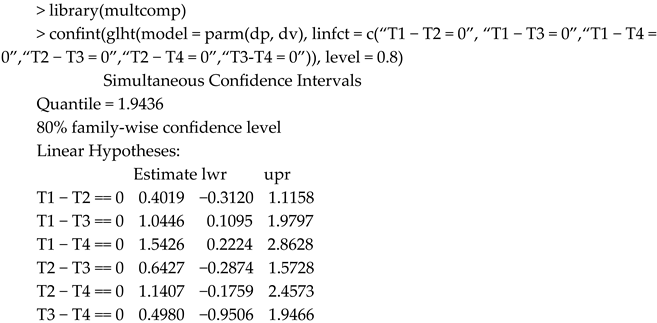
There are significant differences between T1 and T3 and between T1 and T4 (confidence intervals do not include 0), based on δ. Figure 1 shows the simultaneous confidence limits for any pair of the test samples. The R programs produce the same results as those produced by using the S-Plus program ‘multicomp’.
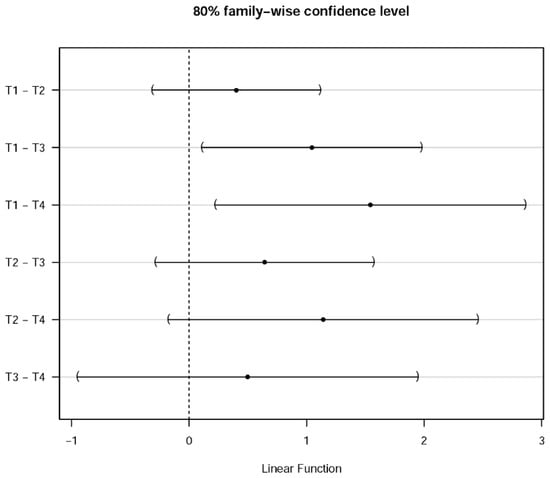
Figure 1.
Multiple comparisons based on vector and co-variance matrix.
3.3.3. TOST Equivalence/Similarity Test Based on Two Values and Their Variances
The R code ‘s2dptest(d,v,d0)’ based on Equations (4a) and (4b) can be used for the TOST equivalence/similarity test for two test samples based on two estimators, e.g., and for test samples T1 and T2 and their variances. The input of the code is the two estimators and their variances, as well as an equivalence/similarity limit . The output of the code are the test statistics Z1 and Z2 and the p-values. For example, for the data d = c(2.4868,2.0849), v = c(0.0687,0.0662), and an equivalence/similarity limit d0 = 1, the output is as below. Significant equivalence/similarity of T1 and T2 can be concluded with an equivalence/similarity limit of 1 at a significance level of 0.1 with p-values of 0.0001 and 0.0517.

The R program ‘TOSTmeta’ in the R package ‘TOSTER’ (Lakens and Caldwell [64]) can also be used for the equivalence/similarity test for two test samples using the two estimators and their variances, as well as an equivalence/similarity limit . For example, for the data above and an equivalence/similarity limit d0 = 1, the same results can be obtained as below. Significant equivalence/similarity of T1 and T2 can be concluded with an equivalence/similarity limit of 1 at a significance level of 0.1 with p-values of 0.0001 and 0.052.
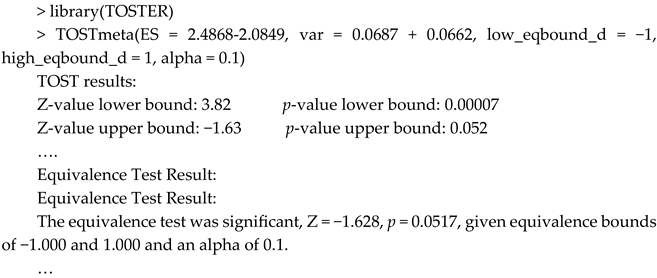
4. Discussion
Thurstonian modeling of sensory discrimination methods is highly effective in enhancing sensory evaluation’s role in food safety by quantifying perceptual differences ( or ) between safe and potentially contaminated food products. Sensory evaluation is an essential frontline tool used primarily to detect and assess potential issues with food quality, spoilage, and contamination, thereby offering valuable insights for early contamination detection and maintaining high food safety and quality standards. Safety concerns for sensory evaluators are of utmost importance. Sensory testing of foods may only be carried out if it is confirmed that the food tested does not have any health hazards (toxins, heavy metals, microbial contamination, etc.). If disposition or handling of the product is unknown or suspect, it should not be consumed for test purposes. Sniff vs. taste testing may be appropriate in certain instances.
4.1. Application of Sensory Discrimination Methods
Sensory evaluation is typically used alongside microbiological and analytical instrumental laboratory testing for a more comprehensive assessment of food safety. Below is how sensory discrimination methods play an important role for monitoring food safety.
- (1)
- Identification of subtle differences before becoming easily perceptible that might indicate spoilage (unpleasant smells, visual changes, taste off-flavors and unexpected texture changes) or foreign substances (chemical residues, cleaning agents, etc.) or contaminants from processing or packaging (metals, dirt, plastics, etc.);
- (2)
- Threshold testing to estimate the minimum level detectable to provide a measurable threshold when a product should be considered changed or unsafe;
- (3)
- For shelf life, quality control, and monitoring quality, an example being rancidity that can develop in fats and oils with age;
- (4)
- Detection of mold odors indicating potential mycotoxins or presence of fermentation or yeast activity in foods;
- (5)
- Contamination from off-flavors during processing due to improper equipment cleaning or cross-contact with other foods;
- (6)
- Determination if consumers can reliably differentiate standard (control) vs. contaminated or adulterated foods or changes in processing environment and the perceived associated consumer risk—how the perception of the sensory difference affects consumer acceptance to align safety margins with consumer expectations for safety and high quality;
- (7)
- For assessor training to increase reliability; and
- (8)
- Development of rapid sensory-based screening tools like electronic noses or tongues by quantifying how these devices mimic human sensory evaluations; Thurstonian models can validate instrumental data accuracy in detecting subtle contamination levels that might not yet be harmful but that could lead to consumer rejection.
4.2. Significance of Differences
In sensory research, helps quantify how significant perceptual differences are and guides decisions related to product development, quality assurance, and consumer testing. In sensory perceptual research, delta () or d-prime () is a key measure derived from Thurstonian models that indicates the degree of perceptual difference between two products. It is commonly used in discrimination tests to quantify how distinct two stimuli are from each other based on sensory attributes. Delta () or d-prime () is a statistical measure of discriminability. It represents the distance between the distributions of sensory perceptions for two products. For example, a higher value indicates a greater difference between the two products, while a lower value indicates they are more similar in sensory perception. The interpretation of d-prime is as below.
- (1)
- No Perceptual Difference ( = 0): A d-prime of zero suggests that the two products are indistinguishable from one another by the assessors. Their sensory distributions completely overlap, meaning any difference perceived by the panel could be due to chance or noise.
- (2)
- Small Perceptual Difference ( between 0.5 and 1.0): A d-prime in this range indicates that there is a slight but perceptible difference between the two products. However, it might be subtle, and not all assessors will consistently detect the difference.
- (3)
- Moderate Perceptual Difference between 1.0 and 2.0): A d-prime in this range suggests a moderate difference that many assessors are likely to detect. It indicates that products are distinguishable based on their sensory characteristics.
- (4)
- Large Perceptual Difference above 2.0): A d-prime greater than 2.0 signals a strong perceptual difference, where most assessors can easily distinguish between the two products. The sensory profiles are clearly different, and these differences are unlikely to be ignored by consumers or trained assessors. In summary, a low indicates products are very similar or indistinguishable, a moderate suggests there is a noticeable difference between products and a high signifies products are highly distinct in sensory perception.
While the above values or ranges of d-prime represent a kind of rule-of-thumb among sensory researchers, it is difficult to give an absolute value for a meaningful d-prime size across all applications. Swets [65] indicates that if a meaningful difference in terms of an area measure (R-index) should be larger than 0.7, the corresponding distance measure () should be larger than 0.74. See further background discussions on Thurstonian discriminal distance d-prime () and R-index based on Thurstonian modeling and Signal Detection Theory (Thurstone [18]; Green and Swets [44]; O’Mahony [66]) for basic effect size measures for perceptual sensory differences. Considering that delta (δ) or d-prime (d′) provides information on the degree of similarity or dissimilarity between two products but does not indicate whether they are the same or different with certainty, then, from a practical perspective, we may say that if the sensory distance between products is so small that they cannot be distinguished, they are interchangeable for a group of respondents at a given significance level.
In practice, researchers use d′ to assess whether the change is perceptible to trained assessors or consumers. If a company wants a product to be indistinguishable from the original, they should aim for a low d′. In quality control, a high d′ might indicate an undesirable variation in production, where products are not consistent with the expected sensory profile. For assessing consumer acceptance, a low d′ suggests the products are similar, which may be acceptable if consistency is the goal. A high d′, however, might require further investigation if sensory differences could impact consumer preference.
For defining the size of d-prime (d′) differences in sensory and psychophysical research, several key references provide foundational insights into the interpretation and application of d′ values. Here are some of the most widely cited sources in this area: detection theory and psychological foundation of d′ [45,46], applied use of d′ in sensory evaluation related to food products [2], statistical power of various discrimination methods and interpretation of d′ [25], detailed guidance on how d′ is calculated and interpreted with linkage of d′ to probabilistic models of perception [67], technical focus on statistical aspects with practical applications of sensory discrimination testing [29]. These references provide a thorough grounding in the use and interpretation of d′ in both general psychophysical contexts and specific sensory research applications.
4.3. Advantages of Thurstonian discriminal distance ( or d′)
Thurstonian scaling for sensory discrimination methods offers advantages in sensory research, particularly in assessing subtle differences between products. Some of the key benefits include the following:
(1) Improved sensitivity, making the method more sensitive to small perceptual differences between products compared to traditional testing; (2) quantitative interpretation, offering a quantitative estimate of the perceived difference between products, enabling researchers to measure and compare the intensity of sensory attributes more precisely; (3) statistical robustness and reliability, accounting for individual variability and response bias, leading to more accurate representations of true sensory differences; (4) clearer decision-making across methods based on a probabilistic framework, facilitating more informed decisions; and (5) compatibility across methods using a common parameter d′, thus allowing selection of the most appropriate method for the nature of the product and study objectives.
As mentioned earlier, Thurstonian scaling can be used with trained panels or consumer panels. Trained panels are used to detail sensory differences, make objective assessments of product formulations, ingredient changes, or quality control, and conduct product optimization to fine-tune product formulations or processes to achieve the desired sensory characteristics. Consumer panels are used to provide critical information on perceptual relevance, helping to quantify if consumers can detect differences between products and, if so, the probability of those differences being meaningful for consumer acceptability and whether sensory differences will impact consumers buying behavior, driving decisions regarding product launch, positioning, or marketing strategies and success in the marketplace. Thurstonian scaling provides quantitative and probabilistic insights, enabling better decision-making in product development and consumer research.
4.4. Application of Thurstonian Scaling for Food Quality and Safety
There are several review articles and research papers that apply Thurstonian scaling in the context of food quality and safety. These articles discuss the use of the scaling in sensory discrimination, consumer testing, and quality control. Recent studies have increasingly applied Thurstonian scaling to monitor and detect food quality and safety, particularly in the fields of sensory analysis, food contamination, and adulteration.
Moreover, other recent studies have emphasized using the scaling to explore consumer perceptions of food safety and quality. These approaches help better understand how sensory attributes contribute to perceived quality, influencing consumer acceptance and purchase decisions. The scaling has also been utilized to improve the accuracy of sensory panels in discriminating between small differences in product formulations, crucial for maintaining consistent food quality standards. Below are some specific review articles, studies, and book chapter content that discuss sensory discrimination methods in this field that are essential references for understanding how analyses and Thurstonian scaling are applied for quality control in the food industry.
Lee and Van Hout [68] deliver a review of practical applications to accurately quantify sensory differences/similarities in food; Lee and O’Mahony [69] and Ennis [26] provide detailed overviews of Thurstonian models in sensory and consumer science, offering examples specific to food products; Lawless [70] gives a review of sensory discrimination testing methods and includes practical applications of Thurstonian models for food quality testing; O’Mahony [66] offers statistical insights and a broader context for Thurstonian models in the evaluation of food quality and safety, providing a framework for interpreting sensory differences using statistical models; Ennis and Rosseau [27], Bi [29] (pp. 171–177), and Bi [71] extend the collection of Thurstonian models with the degree of difference method and other modified discrimination tests, including double discrimination tests by Bi [29] (pp. 177–186).
4.5. Government Organizations
It is worth noting government organizations around the world use sensory evaluation as part of their food safety and quality control measures, which serves to emphasize the importance of this work:
The United States Department of Agriculture (USDA) Food Safety and Inspection Service (FSIS) conducts routine inspections to assess the freshness and quality of meat and poultry products.
The United States Food and Drug Administration (FDA) Center for Food Safety and Applied Nutrition (CFSAN) monitors food quality and potential foodborne hazards in various products such as seafood, dairy, and processed foods.
The European Food Safety Authority (EFSA) provides independent scientific advice on food safety and regularly assesses the risk of various food products; sensory evaluation is part of the risk assessment process for assessing spoilage and quality deterioration, especially in relation to food freshness and storage conditions.
The Canadian Food Inspection Agency (CFIA) enforces food safety regulations in Canada, ensuring foods meet health and safety standards, especially for meat, fish, dairy, and other perishable foods, ensuring food products are safe for consumption.
Food Standards Australia New Zealand (FSANZ) develops food standards for Australia and New Zealand including food labeling, food composition, and food safety; sensory evaluation is used for food quality assessment to ensure compliance with standards for food freshness and quality.
The National Food Institute (Denmark), responsible for food safety and conducting risk assessments, uses sensory evaluation in inspection of food products to ensure that they meet national and EU food safety standards.
The China Food and Drug Administration (CFDA) oversees the safety of food and drugs in China. Sensory evaluation forms part of routine inspections, particularly in assessing the quality and freshness of food products, such as fish, vegetables, and meat, to ensure that they meet safety standards.
The Japan Food Safety Commission (FSC) provides risk assessments to ensure the safety of food products in Japan. Sensory evaluation techniques are used in the food industry to detect spoilage or contamination.
The Department of Agriculture, Fisheries, and Forestry (Australia) enforces food safety and quality standards in Australia’s agriculture and fisheries sectors. Sensory evaluation plays a role in ensuring that food products, particularly perishable items like fish and seafood, are fresh and safe for consumption.
The World Health Organization (WHO) and Food and Agriculture Organization (FAO) provide guidelines and frameworks that national governments use to ensure food safety. These government agencies and organizations integrate sensory evaluation into broader food safety programs to monitor quality, identify potential risks, and ensure consumer safety. They recommend using sensory evaluation alongside laboratory testing to assess food quality and safety.
The National Institutes of Health (NIH): While the NIH does not directly oversee or conduct food safety inspections using sensory evaluation, its research on sensory perception, foodborne illnesses, environmental hazards, and human health contributes significantly to improving food safety standards. NIH-funded research provides valuable insights that are applied in sensory evaluation methods used by regulatory agencies like the FDA and USDA to protect public health.
4.6. Future Trends
Overall, the use of sensory evaluation methods for detecting food contamination is evolving alongside technological advancements, offering both speed and precision in food quality control. Xia [72] accounts for the interest and importance of food quality and safety in food production by summarizing the volume of work published in Food Quality and Safety (FQS) between 2017 and 2022. The future of sensory evaluation for monitoring food safety is driven by advancements in technologies and the increasing demand for real-time, accurate assessments. One of the most effective uses of sensory evaluation for food quality and safety monitoring is the establishment of data relationships between perceptual sources of data and instrumental assessments [73]. Several trends are shaping the future of this field, including the following: (1) integration of digital technologies that mimic human sensory systems (electronic noses and tongues) [74]; artificial intelligence (AI) and machine learning (ML) with algorithms to interpret sensory data [75]; (2) portable and real-time sensors allowing real-time monitoring for immediate feedback along stages of the supply chain [76], though these are often still used in combination with traditional sensory methods for assessing and understanding food quality [77]; Internet of Things (IoT) integration (smart sensors) [76]; (3) nanotechnology (nano-biosensors to detect contaminants at molecular levels) [74]; (4) enhanced consumer sensory feedback (crowdsourcing sensory data, integration of real-time data with smart devices); (5) non-destructive imaging testing techniques to assess food quality and safety without damage to the product [76,78]; (6) personalized food safety monitoring (wearable and smart devices) for real-time assessments in food production, at home, or in restaurants [79,80]; (7) food microbiome detection to predict spoilage or contamination even before it becomes perceptible through traditional sensory methods [76], and advances continue for shelf-life prediction models with development of new models foreseen [81].
In summary, future trends in sensory evaluation for food safety will rely heavily on emerging technologies such as AI, IoT, nanotechnology, and non-destructive testing methods, enabling faster, more precise, and more accessible monitoring systems. These innovations aim to improve food safety at all stages of the supply chain and empower researchers and consumers with better tools. These emerging techniques should benefit from analysis in conjunction with predictive perceptual models to provide precise, quantitative assessments of food safety and help in developing novel methods for detecting food contamination or adulteration [82]. Such applications are critical for both research and industry, where maintaining high standards in food quality is essential. Applied use of Thurstonian modeling of sensory discrimination results serves to contribute to this evolution.
5. Conclusions
Thurstonian scaling, i.e., Thurstonian discriminal distance ( or ) is an advanced technique to measure sensory difference/similarity between two samples. The index can be produced from a Thurstonian model, i.e., a psychometric function of any one of the sensory discrimination methods. There are some published papers on Thurstonian scaling in the sensory literature; however, there are no papers on general statistical inference for data. This paper briefly and comprehensively explores how to estimate and test Thurstonian discrimination distances ( values) and generally discusses the application and significance of Thurstonian scaling for sensory discrimination methods. R codes are developed and provided to calculate values and their variances from 10 basic sensory discrimination methods. The 10 basic sensory discrimination methods include 6 force-choice methods (2-AFC, 3-AFC, triangle, duo-trio, specified tetrad, and unspecified tetrad) and 4 methods with response bias (A–Not A, Same–Different, ratings of A–Not A, and ratings of Same–Different). With the estimated values and their variances, difference testing and equivalence/similarity testing for individual value, or two or multiple values, as well as multiple comparisons for multiple values, can be conducted by using R codes, the S-Plus program, and R packages as shown in the paper.
We believe that the technique of Thurstonian scaling provided and discussed in the paper can be used as a useful tool in several scientific research fields including the area of detecting and monitoring food contamination. As mentioned earlier, advantages include (1) improved sensitivity, (2) quantitative interpretation, (3) statistical robustness and reliability, (4) clearer decision-making across methods based on a probabilistic framework, and (5) compatibility across methods using a common parameter d′. Understanding Thurstonian scaling assumptions and requirements is necessary to apply it successfully. Disadvantages in adopting Thurstonian research might be complexity and accessibility, normality assumptions, and requirement for large, high-quality datasets. Future efforts, improvements and advancements in using Thurstonian scaling for monitoring foods might include the following: (1) integration with digital technologies, nanotechnologies, IOT, AI, ML, multimodal data, and other types of data (sensor data, analytical, microbial, etc.) to provide deeper insights, (2) incorporation of non-linear relationships to handle diverse data, (3) Bayesian extensions to allow for better incorporation of prior information, (4) relaxing distributional assumptions to make Thurstonian models more robust to real-world data, (5) Thurstonian models to analyze data over time or in dynamic contexts (i.e., shelf-life prediction models), and (6) creation of software tools to lower barriers for researchers to apply the models, thus making Thurstonian modeling more versatile, accessible, and capable of addressing modern challenges for food safety.
Supplementary Materials
The following supporting information can be downloaded at: https://www.mdpi.com/article/10.3390/app15020991/s1. The R codes used in this paper and some statistical output can be found in the Supplementary Materials in the online version of this paper.
Author Contributions
Conceptualization, J.B. and C.K.; software, J.B.; formal analysis, J.B.; writing—original draft preparation, J.B. and C.K.; writing—review and editing, J.B. and C.K.; visualization, J.B. All authors have read and agreed to the published version of the manuscript.
Funding
This research received no external funding.
Institutional Review Board Statement
Not applicable.
Informed Consent Statement
Not applicable.
Data Availability Statement
The original contributions presented in the study are included in the article/Supplementary Materials, further inquiries can be directed to the corresponding author.
Conflicts of Interest
Author Carla Kuesten was employed by the company Kuesten Sensory Perception Research, LLC. The remaining authors declare that the research was conducted in the absence of any commercial or financial relationships that could be construed as a potential conflict of interest.
References
- Meilgaard, M.; Civille, G.; Carr, B. Sensory Evaluation Techniques; Taylor & Francis: Boca Raton, FL, USA, 2006. [Google Scholar]
- Lawless, H.T.; Heymann, H. Sensory Evaluation of Food: Principles and Practices, 2nd ed.; Springer: New York, NY, USA, 2010. [Google Scholar]
- Stone, H.; Bleibaum, R.; Thomas, H.A. Sensory Evaluation Practices; Academic Press: New York, NY, USA, 2020. [Google Scholar]
- Rogers, L. Discrimination Testing in Sensory Science: A Practical Handbook; Woodhead Publishing: Duxford, UK, 2017. [Google Scholar]
- Rogers, L.; Hort, J.; Kamp, S.E.; Hollowood, T. Discrimination Testing in Sensory Evaluation; Wiley: Hoboken, NJ, USA, 2024. [Google Scholar]
- ASTM. Annual Book of ASTM Standards; ASTM International: West Conshohocken, PA, USA, 2021; Volume 14. [Google Scholar]
- ASTM-E2262-03; Standard Practice for Estimating Thurstonian Discriminal Distances. ASTM International: West Conshohocken, PA, USA, 2021.
- ASTM-E1885-18; Test Method for Sensory Analysis—Triangle Test. ASTM International: West Conshohocken, PA, USA, 2018.
- ASTM-E3009-24; Standard Test Method for Sensory Analysis—Tetrad Test. ASTM International: West Conshohocken, PA, USA, 2024.
- ASTM-E2610-18; Test Method for Sensory Analysis—Duo-Trio Test. ASTM International: West Conshohocken, PA, USA, 2018.
- ASTM-E2139-05; Standard Test Method for Same-Different Test. ASTM International: West Conshohocken, PA, USA, 2018.
- ASTM-E2164-16; Standard Test Method for Directional Difference Test. ASTM International: West Conshohocken, PA, USA, 2016.
- ISO 4120:2021; Sensory Analysis—Methodology—Triangle Test. ISO: Geneva, Switzerland, 2021. Available online: https://www.iso.org/standard/76666.html (accessed on 17 January 2025).
- EN ISO 5495:2005/Amd 1:2016; Sensory Analysis—Methodology—Paired Comparison Test). ISO: Geneva, Switzerland, 2005. Available online: https://www.iso.org/standard/67425.html (accessed on 17 January 2025).
- ISO 6658:2017; Sensory Analysis—Methodology—General Guidance. ISO: Geneva, Switzerland, 2017. Available online: https://www.iso.org/standard/65519.html (accessed on 17 January 2025).
- ISO 8588:2017; Sensory Analysis—Methodology—“A”—“Not A” Test. ISO: Geneva, Switzerland, 2017. Available online: https://www.iso.org/standard/63403.html (accessed on 17 January 2025).
- ISO 10399:2017; Sensory Analysis—Methodology—Duo-Trio Test. ISO: Geneva, Switzerland, 2017. Available online: https://www.iso.org/standard/74219.html (accessed on 17 January 2025).
- Thurstone, L.L. A law of comparative judgement. Psychol. Rev. 1927, 34, 273–286. [Google Scholar] [CrossRef]
- Ura, S. Pair, triangle, and duo-trio test. Rep. Stat. Appl. Res. JUSE 1960, 7, 107–119. [Google Scholar]
- David, H.A.; Trivedi, M.C. Pair, Triangle, and Duo-Trio Tests; Tech. Rep. 54; Virginia Polytechnic Institute: Blacksburg, VA, USA, 1962. [Google Scholar]
- Bradley, R.A. Some relationship among sensory difference tests. Biometrics 1963, 19, 385–397. [Google Scholar] [CrossRef]
- Frijters, J.E.R. Variations of the triangular method and the relationship of its unidimensional probabilistic models to 3-altenative forced choice signal detection theory models. Br. J. Math. Stat. Psychol. 1979, 32, 229–242. [Google Scholar] [CrossRef]
- Frijters, J.E.R. Sensory difference testing and the measurement of sensory discriminability. In Sensory Analysis of Foods, 2nd ed.; Piggott, J.R., Ed.; Elsevier Applied Science Publishers: London, UK, 1988; pp. 117–140. [Google Scholar]
- Ennis, D.M.; Mullen, K.; Frijters, J.E.R. Variants of the method of triads: Unidimensional Thurstonian models. Br. J. Math. Stat. Psychol. 1988, 41, 25–36. [Google Scholar] [CrossRef]
- Ennis, D.M. The power of discrimination methods. J. Sens. Stud. 1993, 8, 353–370. [Google Scholar] [CrossRef]
- Ennis, D.M. Thurstonian Models: Categorical Decision Making in the Presence of Noise; The Institute for Perception: Richmond, VA, USA, 2016; ISBN 9780990644606/099064460X. [Google Scholar]
- Ennis, D.M.; Rousseau, B. A Thurstonian model for the degree of difference protocol. Food Qual. Prefer. 2015, 41, 159–162. [Google Scholar] [CrossRef]
- Bi, J.; Ennis, D.M.; O’Mahony, M. How to estimate and use the variance of d’ from difference tests. J. Sens. Stud. 1997, 12, 87–104. [Google Scholar] [CrossRef]
- Bi, J. Sensory Discrimination Tests and Measurements: Sensometrics in Sensory Evaluation, 2nd ed.; Wiley; Blackwell Publishing: Oxford, UK, 2015. [Google Scholar]
- Bi, J. Variance of d’ for the same-different method. Behav. Res. Methods Instrum. Comput. 2002, 34, 37–45. [Google Scholar] [CrossRef]
- Bi, J. The methods of Tetrads, Hexads, and Octads: A type of more powerful sensory discrimination methods. Food Qual. Prefer. 2023, 108, 104879. [Google Scholar] [CrossRef]
- Bi, J.; O’Mahony, M. Variance of d’ for the tetrad test and comparisons with other forced choice methods. J. Sens. Stud. 2013, 28, 91–101. [Google Scholar] [CrossRef]
- Bi, J.; Kuesten, C. Review and development of Thurstonian models for the triangle and duo-trio methods and paired versions of the methods. J. Sens. Stud. 2020, 35, e12569. [Google Scholar] [CrossRef]
- Bi, J.; Kuesten, C. Thurstonian models for the duo-trio and its variants. J. Sens. Stud. 2024, 39, e12949. [Google Scholar] [CrossRef]
- Bi, J.; Lee, H.S.; O’Mahony, M. Statistical analysis of ROC curves for the ratings of the A-Not A and the Same-Different methods. J. Sens. Stud. 2013, 28, 34–46. [Google Scholar] [CrossRef]
- Bi, J.; Lee, H.S.; O’Mahony, M. Estimation of Thurstonian models for various forced-choice sensory discrimination methods as a form of the ‘M+N’ test. J. Sens. Stud. 2014, 29, 325–338. [Google Scholar] [CrossRef]
- Bi, J.; Kuesten, C.; Lee, H.S.; O’Mahony, M. Paired versions of various sensory discrimination forced-choice methods and the same-different area theorem. Food Qual. Prefer. 2018, 63, 97–106. [Google Scholar] [CrossRef]
- Brockhoff, B.P.; Christensen, R.H.B. Thurstonian models for sensory discrimination tests as generalized linear models. Food Qual. Prefer. 2010, 21, 330–338. [Google Scholar] [CrossRef]
- Ennis, J.M. A Thurstonian analysis of the Two-Out-of-Five test. J. Sens. Stud. 2013, 28, 295–303. [Google Scholar] [CrossRef]
- Ennis, J.M.; Christensen, R. Thurstonian comparison of the Tetrad and Degree of Difference tests. J. Food Qual. Prefer. 2015, 40, 263–269. [Google Scholar] [CrossRef]
- Ennis, J.M.; Rousseau, B.; Ennis, D.M. Sensory difference tests as measurement instruments: A review of recent advances. J. Sens. Stud. 2014, 29, 89–102. [Google Scholar] [CrossRef]
- Rousseau, B.; O’Mahony, M. Sensory difference tests: Thurstonian and SSA predictions for vanilla flavored yogurts. J. Sens. Stud. 1997, 12, 127–146. [Google Scholar] [CrossRef]
- Rousseau, B.; Ennis, D.N. A Thurstonian model for the dual pair (4IAX) discrimination method. Percept. Psychophys. 2001, 63, 1083–1090. [Google Scholar] [CrossRef] [PubMed][Green Version]
- Green, D.M.; Swets, J.W. Signal Detection Theory and Psychophysics; Wiley: New York, NY, USA, 1966. [Google Scholar]
- Macmillan, N.A.; Creelman, C.D. Detection Theory: A User’s Guide, 2nd ed.; Lawrence Erlbaum Associates, Inc.: New York, NY, USA, 2004. [Google Scholar]
- Hautus, M.J.; Macmillan, N.A.; Creelman, C.D. Detection Theory: A User’s Guide, 3rd ed.; Taylor & Francis: New York, NY, USA, 2022. [Google Scholar]
- Christensen, R.H.B.; Brockhoff, B.P.; Kuznetsova, A.; Birot, S.; Stachlewska, K.A.; Rafacz, D. Package ‘sensR’. 2023. Available online: https://cran.r-project.org/web/packages/SensoMineR/index.html (accessed on 17 January 2025).
- Ennis, D.M.; Ennis, J.M. Analysis and Thurstonian scaling of applicability scores. J. Sens. Stud. 2013, 28, 188–193. [Google Scholar] [CrossRef]
- Warnock, A.R.; Shumaker, A.N.; Delwiche, J.F. Consideration of Thurstonian scaling of ratings data. Food Qual. Prefer. 2006, 17, 556–561. [Google Scholar] [CrossRef]
- R Core Team R: A Language and Environment for Statistical Computing; R Foundation for Statistical Computing: Vienna, Austria. 2023. Available online: https://www.R-project.org/ (accessed on 17 January 2025).
- Insightful. S-PLUS 6. In Guide to Statistics Vol.1. for Windows; Insightful Corporation: Seattle, WA, USA, 2001. [Google Scholar]
- Gilbert, P.; Varadhan, R. Accurate Numerical Derivatives, R Package “numDeriv”. 2019. Available online: https://cran.r-project.org/web/packages/numDeriv/index.html (accessed on 17 January 2025).
- Ennis, J.; Ennis, D.; Yip, D.; O’Mahony, M. Thurstonian models for variants of the method of tetrads. Brit. J. Math. Stat. Psychol. 1998, 51, 205–215. [Google Scholar] [CrossRef]
- Marascuilo, L.A. Large sample multiple comparisons. Psychol. Bull. 1966, 65, 280–290. [Google Scholar] [CrossRef] [PubMed]
- Marascuilo, L.A. Extension of the significance test for one-parameter signal detection hypotheses. Psychometrika 1970, 35, 237–243. [Google Scholar] [CrossRef]
- Hothorn, T.; Bretz, F.; Westfall, P.; Heiberger, R.M.; Schuetzenmeister, A.; Scheibe, S. R Package “multcomp”: Simultaneous Inference in General Parametric Models. 2023. Available online: https://cran.r-project.org/web/packages/multcomp/index.html (accessed on 17 January 2025).
- Westlake, W.J. Response to T.B.L. Kirkwood: Bioequivalence testing—A need to rethink. Biometrics 1981, 37, 589–594. [Google Scholar]
- Schuirmann, D.J. On hypothesis testing to determine if the mean of a normal distribution is contained in a known interval. Biometrics 1981, 37, 617. [Google Scholar]
- Schuirmann, D.J. A comparison of the two one-sided tests procedure and the power approach for assessing the equivalent of average bioavailability. J. Pharmacokinet. Biopharm. 1987, 15, 657–680. [Google Scholar] [CrossRef]
- Berger, R.L. Multiparameter hypothesis testing and acceptance sampling. Technometrics 1982, 24, 295–300. [Google Scholar] [CrossRef]
- Casella, G.; Berger, R.L. Statistical Reference; Wadsworth and Brooks/Cole: Pacific Grove, CA, USA, 1990. [Google Scholar]
- Berger, R.L.; Hsu, J.C. Bioequivalence trials, intersection union tests and equivalence confidence set. Stat. Sci. 1996, 11, 283–319. [Google Scholar] [CrossRef]
- Silvapulle, M.J.; Sen, P.K. Constrained Statistical Inference: Inequality, Order, and Shape Restrictions; Wiley: New York, NY, USA, 2004. [Google Scholar]
- Lakens, D.; Caldwell, A. R Package “TOSTER”: Two One-Sided Tests (TOST) Equivalence Testing. 2023. Available online: https://cran.r-project.org/web/packages/TOSTER/index.html (accessed on 17 January 2025).
- Swets, J.A. Measuring the accuracy of diagnostic systems. Science 1988, 240, 1285–1293. [Google Scholar] [CrossRef] [PubMed]
- O’Mahony, M. Understanding discrimination tests: A user-friendly treatment of response bias, rating and ranking R-Index tests and their relationship to signal detection. J. Sens. Stud. 1992, 7, 1–47. [Google Scholar] [CrossRef]
- Ennis, D.M.; Rousseau, B.; Ennis, J.M. Tools and Applications of Sensory and Consumer Science; The Institute for Perception: Richmond, VA, USA, 2017. [Google Scholar]
- Lee, H.-S.; Van Hout, D. Quantification of Sensory and Food Quality: The R-Index Analysis. J. Food Sci. 2009, 74, R57–R64. [Google Scholar] [CrossRef] [PubMed]
- Lee, H.-S.; O’Mahony, M. Sensory difference testing: Thurstonian models. Food Sci. Biotechnol. 2004, 13, 841–847. [Google Scholar]
- Lawless, H.T. Chapter 4 Thurstonian Models for Discrimination and Preference. In Quantitative Sensory Analysis Psychophysics, Models and Intelligent Design; John Wiley & Sons, Ltd., Wiley Blackwell: Hoboken, NJ, USA, 2013; pp. 71–123. [Google Scholar]
- Bi, J. Statistical models for the Degree of Difference method. J. Food Qual. Prefer. 2002, 13, 31–37. [Google Scholar] [CrossRef]
- Xia, T.; Gong, C.; Zeng, J. Publication review of Food Quality and Safety during 2017–2022. Food Qual. Saf. 2023, 7, fyad062. [Google Scholar] [CrossRef]
- Ray, S. Sensory Properties of Foods and Their Measurement Methods. In Techniques to Measure Food Safety and Quality; Khan, M.S., Shafiur Rahman, M., Eds.; Springer: Cham, Switzerland, 2021. [Google Scholar] [CrossRef]
- Kumar, A.; Castro, M.; Feller, J.-F. Review on Sensor Array-Based Analytical Technologies for Quality Control of Food and Beverages. Sensors 2023, 23, 4017. [Google Scholar] [CrossRef] [PubMed]
- Ma, M.; Yang, X.; Ying, X.; Shi, C.; Jia, Z.; Jia, B. Applications of Gas Sensing in Food Quality Detection: A Review. Foods 2023, 12, 3966. [Google Scholar] [CrossRef] [PubMed]
- Rodrigues, S.S.; Dias, L.G.; Telxeria, A. Emerging Methods for the Evaluation of Sensory Quality of Food: Technology at Service. Curr. Food Sci. Technol. Rep. 2024, 2, 77–90. [Google Scholar] [CrossRef]
- Sirangelo, T.M. Sensory Descriptive Evaluation of Food Products: A Review. J. Food Sci. Nutr. Res. 2019, 2, 354–363. [Google Scholar] [CrossRef]
- Perumal, A.B.; Li, X.; He, Y. Special Issue “Recent Advances in the Food Safety and Quality Management Techniques”. Foods 2024, 13, 4165. [Google Scholar] [CrossRef] [PubMed]
- Huang, Y.; Luo, C.; Xia, F.; Song, Y.; Jiang, L.; Li, F. Multi-analyte sensing strategies towards wearable and intelligent devices. Chem. Sci. 2022, 13, 12309–12325. [Google Scholar] [CrossRef]
- Liberty, J.T.; Sun, S.; Kucha, C.; Adedeji, A.A.; Agidi, G.; Ngadi, M.O. Augmented reality for food quality assessment: Bridging the physical and digital worlds. J. Food Eng. 2024, 367, 111893. [Google Scholar] [CrossRef]
- Cui, F.; Zheng, S.; Wang, D.; Tan, X.; Li, Q.; Li, J.; Li, T. Recent advances in shelf life prediction models for monitoring food quality. Compr. Rev. Food Sci. Food Saf. 2023, 22, 1257–1284. [Google Scholar] [CrossRef]
- Valdramidis, V.; Cummins, E.; Celayeta, J.M.F. Predictive Modelling of Food Quality and Safety Special Issue. Food Control 2013, 29, 289–470. [Google Scholar] [CrossRef]
Disclaimer/Publisher’s Note: The statements, opinions and data contained in all publications are solely those of the individual author(s) and contributor(s) and not of MDPI and/or the editor(s). MDPI and/or the editor(s) disclaim responsibility for any injury to people or property resulting from any ideas, methods, instructions or products referred to in the content. |
© 2025 by the authors. Licensee MDPI, Basel, Switzerland. This article is an open access article distributed under the terms and conditions of the Creative Commons Attribution (CC BY) license (https://creativecommons.org/licenses/by/4.0/).